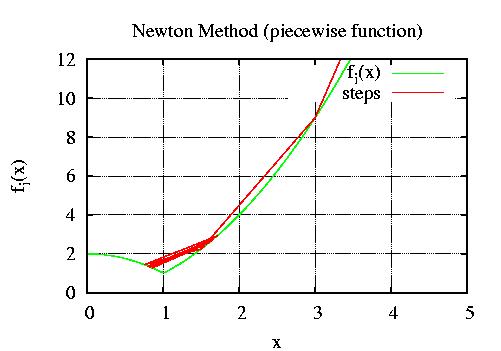PROGRAM main
REAL tol, x, xd, tmp1, tmp1d
INTEGER r, it
tol = 1.0e-3
r = 0
x = 6
WRITE(*, '(/, A, F3.1)') ' Initial guess: ', x
xd = 1
WRITE(*, '(A, F3.1)') ' Initial guess direction: ', xd
it = 20
WRITE(*, '(A, I4)') ' Iteration times: ', it
WRITE(*, '(/, A)') " x f(x) f'(x)"
DO
CALL F_D( x, xd, tmp1, tmp1d )
WRITE(*, '(3(F9.5, X))') x, tmp1, tmp1d
C
x = x - ( tmp1 / tmp1d )
IF ( ABS( tmp1d ) < tol ) EXIT
r = r + 1
IF ( r > it ) EXIT
END DO
END
SUBROUTINE F( x, y )
REAL x, y
IF ( x > 1 ) THEN
y = x**2
ELSE
y = 2-x**2
ENDIF
END
Applying TAPENADE to obtain the derivatives (subroutine F_D )
> tapenade -d -root F -vars "x" -outvars "y" newton-piecewise.f
Tapenade - Version 2.1 - (Id: 1.33 vmp Stable - Wed Jan 12 13:35:07 MET 2005) -
Java 1.5.0_02
File: (TC33) External procedure f_d is not declared
@@ Creating ./f_d.f
job is completed
> cat f_d.f
C Generated by TAPENADE (INRIA, Tropics team)
C Version 2.1 - (Id: 1.33 vmp Stable - Wed Jan 12 13:35:07 MET 2005)
C
C Differentiation of f in forward (tangent) mode:
C variations of output variables: y
C with respect to input variables: x
C
SUBROUTINE F_D(x, xd, y, yd)
IMPLICIT NONE
REAL x, xd, y, yd
C
IF (x .GT. 1) THEN
yd = 2*x*xd
y = x**2
ELSE
yd = -(2*x*xd)
y = 2 - x**2
END IF
END
Compiling
> g77 -c f_d.f > g77 f_d.o newton-piecewise.f -o newton-piecewise
Initial guess: 6.0
Initial guess direction: 1.0
Iteration times: 20
x f(x) f'(x)
6.00000 36.00000 12.00000
3.00000 9.00000 6.00000
1.50000 2.25000 3.00000
0.75000 1.43750 -1.50000
1.70833 2.91840 3.41667
0.85417 1.27040 -1.70833
1.59782 2.55301 3.19563
0.79891 1.36175 -1.59782
1.65116 2.72634 3.30233
0.82558 1.31842 -1.65116
1.62406 2.63756 3.24812
0.81203 1.34061 -1.62406
1.63750 2.68140 3.27500
0.81875 1.32965 -1.63750
1.63075 2.65935 3.26150
0.81538 1.33516 -1.63075
1.63412 2.67034 3.26823
0.81706 1.33242 -1.63412
1.63243 2.66483 3.26486
0.81622 1.33379 -1.63243
1.63327 2.66758 3.26655

> tapenade -dV -root F -vars "x" -outvars "y" newton-piecewise.f
Tapenade - Version 2.1 - (Id: 1.33 vmp Stable - Wed Jan 12 13:35:07 MET 2005) -
Java 1.5.0_02
File: (TC33) External procedure f_dva is not declared
@@ Creating ./f_dva.f
job is completed
> cat f_dva.f
C Generated by TAPENADE (INRIA, Tropics team)
C Version 2.1 - (Id: 1.33 vmp Stable - Wed Jan 12 13:35:07 MET 2005)
C
C Differentiation of f in forward (tangent) validated mode:
C variations of output variables: y
C with respect to input variables: x
C
SUBROUTINE F_DVA(x, xd, y, yd)
IMPLICIT NONE
REAL x, xd, y, yd
yd = 0.0
C
CALL VALIDITY_TEST(x - 1, xd)
IF (x .GT. 1) THEN
yd = 2*x*xd
y = x**2
ELSE
yd = -(2*x*xd)
y = 2 - x**2
END IF
END
PROGRAM main
REAL tol, x, xd, tmp1, tmp1d
INTEGER r, it
INTEGER tmp2, tmp3
COMMON /validity_test_common/ gmin, gmax, infmin, infmax
REAL gmin, gmax
LOGICAL infmin, infmax
tol = 1.0e-3
r = 0
x = 6
WRITE(*, '(/, A, F3.1)') ' Initial guess: ', x
xd = 1
WRITE(*, '(A, F3.1)') ' Initial guess direction: ', xd
it = 20
WRITE(*, '(A, I4)') ' Iteration times: ', it
WRITE(*, '(/, A)') " x f(x) f'(x) gmin gmax
+ infmin infmax"
DO
gmin=.0
gmax=.0
infmin=.TRUE.
infmax=.TRUE.
CALL F_DVA(x, xd, tmp1, tmp1d)
IF ( infmin .eqv. .TRUE. ) THEN
tmp2 = 1
ELSE
tmp2 = 0
END IF
IF ( infmax .eqv. .TRUE. ) THEN
tmp3 = 1
ELSE
tmp3 = 0
END IF
WRITE(*, '(5(F9.5, X), I5, X, I5)') x, tmp1, tmp1d, gmin, gmax
+ , tmp2, tmp3
C
x = x - ( tmp1 / tmp1d )
IF ( abs( tmp1d ) < tol ) EXIT
r = r + 1
IF ( r > it ) EXIT
END DO
END
SUBROUTINE F( x, y )
REAL x, y
IF ( x > 1 ) THEN
y = x**2
ELSE
y = 2-x**2
ENDIF
END
Compiling
> g77 -c f_dva.f > g77 validity_test2.o f_dva.o newton-piecewise-validity.f -o newton-piecewise-validityResults
Initial guess: 6.0
Initial guess direction: 1.0
Iteration times: 20
x f(x) f'(x) gmin gma infmin infmax
6.00000 36.00000 12.00000 5.00000 0.00000 0 1
3.00000 9.00000 6.00000 2.00000 0.00000 0 1
1.50000 2.25000 3.00000 0.50000 0.00000 0 1
0.75000 1.43750 -1.50000 0.00000 0.25000 1 0
1.70833 2.91840 3.41667 0.70833 0.00000 0 1
0.85417 1.27040 -1.70833 0.00000 0.14583 1 0
1.59782 2.55301 3.19563 0.59782 0.00000 0 1
0.79891 1.36175 -1.59782 0.00000 0.20109 1 0
1.65116 2.72634 3.30233 0.65116 0.00000 0 1
0.82558 1.31842 -1.65116 0.00000 0.17442 1 0
1.62406 2.63756 3.24812 0.62406 0.00000 0 1
0.81203 1.34061 -1.62406 0.00000 0.18797 1 0
1.63750 2.68140 3.27500 0.63750 0.00000 0 1
0.81875 1.32965 -1.63750 0.00000 0.18125 1 0
1.63075 2.65935 3.26150 0.63075 0.00000 0 1
0.81538 1.33516 -1.63075 0.00000 0.18462 1 0
1.63412 2.67034 3.26823 0.63412 0.00000 0 1
0.81706 1.33242 -1.63412 0.00000 0.18294 1 0
1.63243 2.66483 3.26486 0.63243 0.00000 0 1
0.81622 1.33379 -1.63243 0.00000 0.18378 1 0
1.63327 2.66758 3.26655 0.63327 0.00000 0 1

Interpretation:
For every step we have the validity interval [gmin, gmax] which shows the "safe differential" area around your input. In the present example the problem is point (1.0, 1.0). For instance, the step (3.0, 9.0) has a validity interval [2.0, +inf], which means that on the direccion of derivation (xd=1) there is no problem (+inf), but on the opposite direction we have a problem 2.0 units far from the step.
A second and more appealing example is under development.